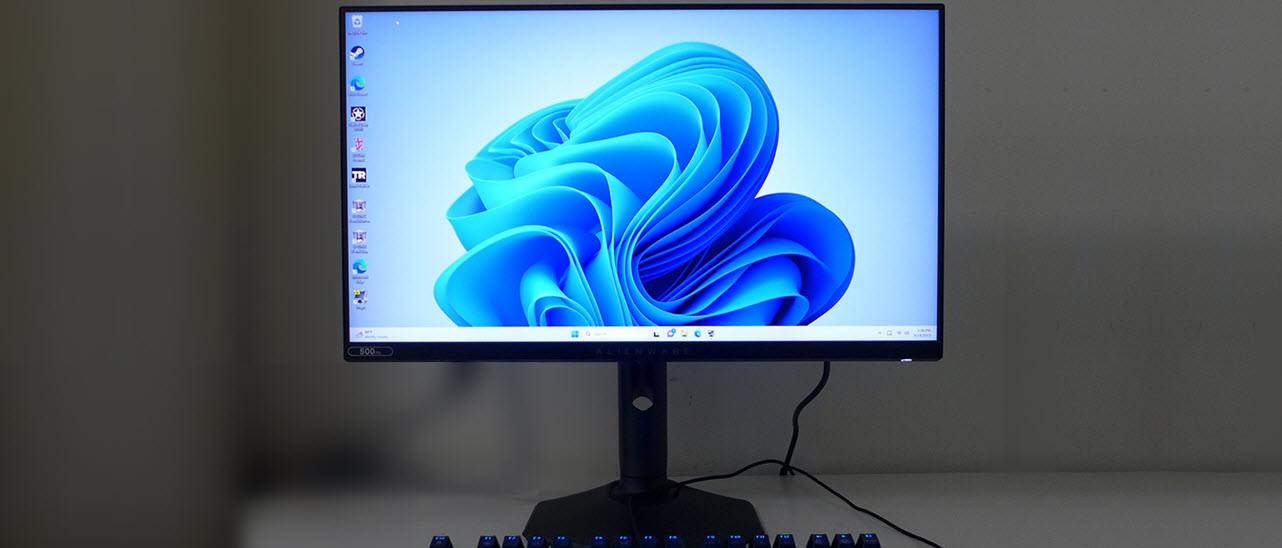Why you can trust Tom's Hardware
To compare the AW2524HF’s performance, I rounded up the fastest monitors in my test database, which all turned out to be from either Alienware or AOC. They are the Alienware AW2524H and AW2523HG; and AOC’s AG254FG, C27G2Z and AG276QZD OLED. Refresh rates run from 240 to 500 Hz.
Pixel Response and Input Lag
Click here to read up on our pixel response and input lag testing procedures.


The test results show some interesting things. First, the costliest monitor here is also the quickest. The AW2524H has a 4ms advantage in total control lag, which is significant to the most skilled players. Second, there is no panel response advantage between 500 and 360 Hz. Motion resolution is visually identical to the naked eye in test patterns and actual content. It should be noted that the OLED AG276QZD has the same visual motion quality as the 500 Hz panels. This is a perception, not something that can be measured.
Test Takeaway: There are a few things worth considering here. The three Alienware monitors range in price from $420 for the 360 Hz model to $820 for the 500 Hz G-Sync display, with the AW2524HF in between at $650. $820 will buy you the lowest input lag on the planet. But if smooth motion is more important to you, the $800 AG276QZD OLED is the best choice. And since it’s a QHD 240 Hz display, it won’t require as much video card power to hit its maximum frame rate.
Viewing Angles
The AW2524HF has some of the best IPS viewing angles I’ve seen. The color shift at 45 degrees off-center is barely visible. If you look closely, you can see a little red in the brighter steps. Peak white is only about 10% dimmer, which is also much better than normal. The top view has a green shift and 50% light falloff. This is excellent performance that is only outperformed by an OLED panel.
Screen Uniformity
To learn how we measure screen uniformity, click here.

The AW2524HF scored reasonably well in my uniformity test by squeaking in under 10%. There were no visible issues when viewing a black field pattern. My luminance meter picked up slight hotspots in the upper right and lower left but they were not visible to the naked eye.
Get Tom's Hardware's best news and in-depth reviews, straight to your inbox.
MORE: Best Gaming Monitors
MORE: How We Test PC Monitors
MORE: How to Buy a PC Monitor
MORE: How to Choose the Best HDR Monitor
Current page: Response, Input Lag, Viewing Angles and Uniformity
Prev Page Features and Specifications Next Page Brightness and Contrast
Christian Eberle is a Contributing Editor for Tom's Hardware US. He's a veteran reviewer of A/V equipment, specializing in monitors. Christian began his obsession with tech when he built his first PC in 1991, a 286 running DOS 3.0 at a blazing 12MHz. In 2006, he undertook training from the Imaging Science Foundation in video calibration and testing and thus started a passion for precise imaging that persists to this day. He is also a professional musician with a degree from the New England Conservatory as a classical bassoonist which he used to good effect as a performer with the West Point Army Band from 1987 to 2013. He enjoys watching movies and listening to high-end audio in his custom-built home theater and can be seen riding trails near his home on a race-ready ICE VTX recumbent trike. Christian enjoys the endless summer in Florida where he lives with his wife and Chihuahua and plays with orchestras around the state.
-
Sluggotg When the early First Person Shooters showed up, (Doom, Rise of the Triad, Descent etc.), 10 FPS was considered playable. 24 FPS was thought to be perfect because that is the Frame Rate of Film. Then the hardware caught up and we saw what 60 FPS looked like. That was a "Game Changer", (Pun intended).Reply
I love a high frame rates. 144 FPS is great. Do I need 500 FPS, not likely, but I do want to try it. My only complaint is the size. I wish it was bigger. -
Kamen Rider Blade My main issue is that it's using IPS for 500 Hz VRR.Reply
IPS doesn't have the pixel reaction time to support 500 Hz w/o ghosting.
It's not like OLED or classic CRT.
Yes, you can OC the panel to support it, but there will be issues with it. -
Sleepy_Hollowed Reply
I don't know about 500 Hz, but it works pretty good up to 160 Hz, no ghosting.Kamen Rider Blade said:My main issue is that it's using IPS for 500 Hz VRR.
IPS doesn't have the pixel reaction time to support 500 Hz w/o ghosting.
It's not like OLED or classic CRT.
Yes, you can OC the panel to support it, but there will be issues with it.
I'd imagine that's imperceptible at those refresh rates, but I'd have to see it in person. -
UnforcedERROR ReplySluggotg said:My only complaint is the size. I wish it was bigger.
Whose Line is it Anyway moment: Comments your girlfriend might say about you or your TV.
Joking aside, 25" at 1080p is about all you'd ever want, really. Unless you're gaming at a considerable difference, I'd never personally recommend a monitor larger than 25" if it's 1080p, because the pixel density is pretty low up close. I mean, the 500hz is because it's at 1080p, and this is mostly for diehard FPS players, but I'd still prefer lower refresh for higher pixel density.

